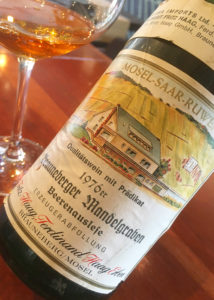
1976 Weingut Fritz Haag – Ferdinand Haag Erben, Riesling Beerenauslese, Brauneberger Mondelgroben, Mosel-Saar-Ruwer, Germany.
What an amazing treat to try the 1976 Beerenauslese from Fritz Haag, and even this was a less than perfect bottle, it was absolutely gorgeous and still fresh and graceful, losing sweetness and picking up the legendary complexity of pedigreed handcrafted sweet wine and showing a light Botrytis honeycomb and trufflely earthiness. The terrifyingly steep Brauneberg hillside has been revered as a top vineyard site since the Romans first cultivated wine grapes in the Mosel valley. In their day it was called “dulcis mons,” which is Latin for “sweet mountain” is home to Fritz Haag, one the Central Mosel’s finest wine estates known for their amazing long lived Riesling grown on pure slate soils. This Beerenauslese comes from the Brauneberger Mondelgroben cru, a lower parcel with a slightly more humid condition that promotes noble rot in some years, though is now rarely used as a single site bottling, which was brought to my attention by a collector of fine Germany wines. This 1976 gives a star performance in the glass with a golden/amber hue and lovely nose of wilted roses, salted caramel, autumn leaves, clove and dried honey with tangerine, baked apricot, lemon curd, crystalized ginger, chamomile tea, wild mushrooms and apple butter. The texture is dreamy smooth, and while sweet and concentrated it is graced with a remarkable lift of acidity still pumping energy through this well balanced old Riesling.
The historic Fritz Haag wine estate is located in the heart of Germany’s middle Mosel River Valley, where it is known for its classic and traditional Riesling wines in Kabinett, Spatlese and Auslese levels, while most recently they added a dry GG from their top Grand Cru vineyard. The earliest documentation of the estate, according to Haag’s importer the Loosen Bros., dates back to 1605 when the local village was known as “Dusemond.” Though, like in Burgundy, In 1925, this village was renamed “Brauneberg” (“brown mountain,” a reference to the color of the slate soil in this area of the Mosel) in an endeavour to further promote the reputation of its world-renowned vineyards “Brauneberger Juffer” and “Brauneberger Juffer Sonnenuhr.” The Loosen’s add, that this excellent micro-climate and the deep slate soils of the Brauneberg hillside yield some of the most intensely flavored and elegantly-structured Riesling wines of the Mosel region, which after having this and many other of Haag’s wines over the years has convinced me of the greatness here, having loved Fritz’s wines and in modern times, since the 2005 vintage, his son Oliver’s fine examples. Sadly, with climate change and modern tastes, these kind of wines are getting scarce, and that it why finding them is a treasure, I am thrilled and grateful to have enjoyed a nice pour of this delicious slightly waxy nectar.
($N/A) 96 Points, grapelive